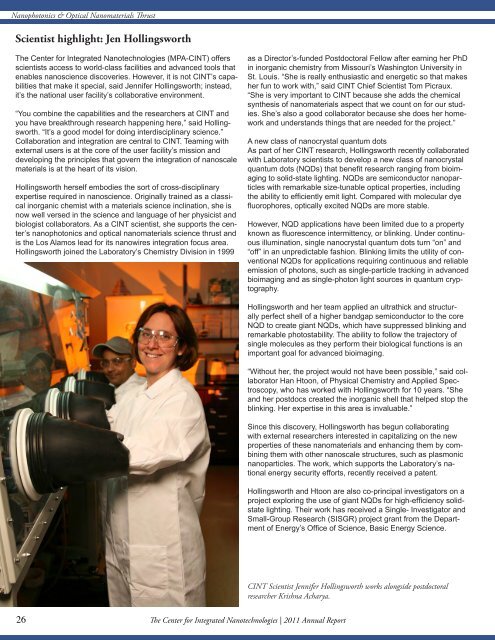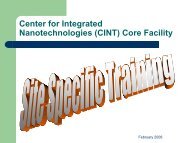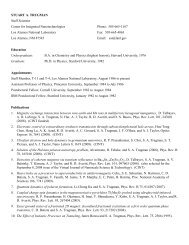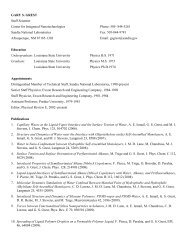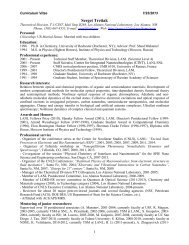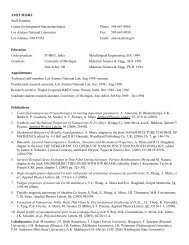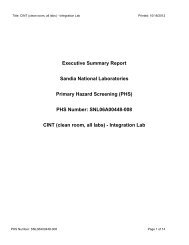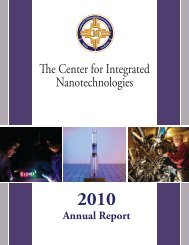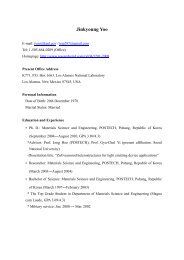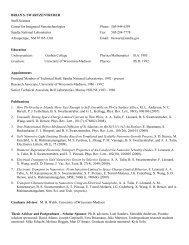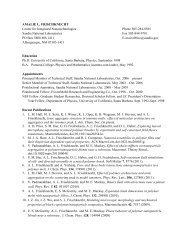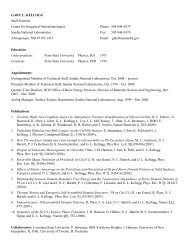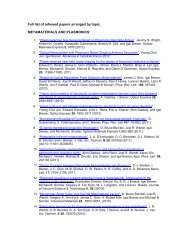2011 Annual Report - Center for Integrated Nanotechnologies - Los ...
2011 Annual Report - Center for Integrated Nanotechnologies - Los ...
2011 Annual Report - Center for Integrated Nanotechnologies - Los ...
You also want an ePaper? Increase the reach of your titles
YUMPU automatically turns print PDFs into web optimized ePapers that Google loves.
Nanophotonics & Optical Nanomaterials Thrust<br />
Scientist highlight: Jen Hollingsworth<br />
The <strong>Center</strong> <strong>for</strong> <strong>Integrated</strong> <strong>Nanotechnologies</strong> (MPA-CINT) offers<br />
scientists access to world-class facilities and advanced tools that<br />
enables nanoscience discoveries. However, it is not CINT’s capabilities<br />
that make it special, said Jennifer Hollingsworth; instead,<br />
it’s the national user facility’s collaborative environment.<br />
“You combine the capabilities and the researchers at CINT and<br />
you have breakthrough research happening here,” said Hollingsworth.<br />
“It’s a good model <strong>for</strong> doing interdisciplinary science.”<br />
Collaboration and integration are central to CINT. Teaming with<br />
external users is at the core of the user facility’s mission and<br />
developing the principles that govern the integration of nanoscale<br />
materials is at the heart of its vision.<br />
Hollingsworth herself embodies the sort of cross-disciplinary<br />
expertise required in nanoscience. Originally trained as a classical<br />
inorganic chemist with a materials science inclination, she is<br />
now well versed in the science and language of her physicist and<br />
biologist collaborators. As a CINT scientist, she supports the center’s<br />
nanophotonics and optical nanomaterials science thrust and<br />
is the <strong>Los</strong> Alamos lead <strong>for</strong> its nanowires integration focus area.<br />
Hollingsworth joined the Laboratory’s Chemistry Division in 1999<br />
as a Director’s-funded Postdoctoral Fellow after earning her PhD<br />
in inorganic chemistry from Missouri’s Washington University in<br />
St. Louis. “She is really enthusiastic and energetic so that makes<br />
her fun to work with,” said CINT Chief Scientist Tom Picraux.<br />
“She is very important to CINT because she adds the chemical<br />
synthesis of nanomaterials aspect that we count on <strong>for</strong> our studies.<br />
She’s also a good collaborator because she does her homework<br />
and understands things that are needed <strong>for</strong> the project.”<br />
A new class of nanocrystal quantum dots<br />
As part of her CINT research, Hollingsworth recently collaborated<br />
with Laboratory scientists to develop a new class of nanocrystal<br />
quantum dots (NQDs) that benefit research ranging from bioimaging<br />
to solid-state lighting. NQDs are semiconductor nanoparticles<br />
with remarkable size-tunable optical properties, including<br />
the ability to efficiently emit light. Compared with molecular dye<br />
fluorophores, optically excited NQDs are more stable.<br />
However, NQD applications have been limited due to a property<br />
known as fluorescence intermittency, or blinking. Under continuous<br />
illumination, single nanocrystal quantum dots turn “on” and<br />
“off” in an unpredictable fashion. Blinking limits the utility of conventional<br />
NQDs <strong>for</strong> applications requiring continuous and reliable<br />
emission of photons, such as single-particle tracking in advanced<br />
bioimaging and as single-photon light sources in quantum cryptography.<br />
Hollingsworth and her team applied an ultrathick and structurally<br />
perfect shell of a higher bandgap semiconductor to the core<br />
NQD to create giant NQDs, which have suppressed blinking and<br />
remarkable photostability. The ability to follow the trajectory of<br />
single molecules as they per<strong>for</strong>m their biological functions is an<br />
important goal <strong>for</strong> advanced bioimaging.<br />
“Without her, the project would not have been possible,” said collaborator<br />
Han Htoon, of Physical Chemistry and Applied Spectroscopy,<br />
who has worked with Hollingsworth <strong>for</strong> 10 years. “She<br />
and her postdocs created the inorganic shell that helped stop the<br />
blinking. Her expertise in this area is invaluable.”<br />
Since this discovery, Hollingsworth has begun collaborating<br />
with external researchers interested in capitalizing on the new<br />
properties of these nanomaterials and enhancing them by combining<br />
them with other nanoscale structures, such as plasmonic<br />
nanoparticles. The work, which supports the Laboratory’s national<br />
energy security ef<strong>for</strong>ts, recently received a patent.<br />
Hollingsworth and Htoon are also co-principal investigators on a<br />
project exploring the use of giant NQDs <strong>for</strong> high-efficiency solidstate<br />
lighting. Their work has received a Single- Investigator and<br />
Small-Group Research (SISGR) project grant from the Department<br />
of Energy’s Office of Science, Basic Energy Science.<br />
CINT Scientist Jennifer Hollingsworth works alongside postdoctoral<br />
researcher Krishna Acharya.<br />
26<br />
26The <strong>Center</strong> <strong>for</strong> <strong>Integrated</strong> <strong>Nanotechnologies</strong> | <strong>2011</strong> <strong>Annual</strong> <strong>Report</strong>


